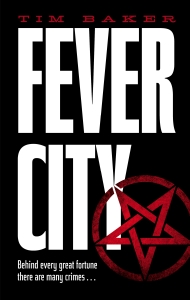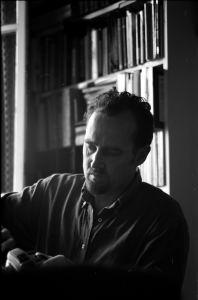Fever City – Tim Baker
 Tim Baker, author of ‘Fever City’ has set himself a very high bar for his crime fiction debut.
Tim Baker, author of ‘Fever City’ has set himself a very high bar for his crime fiction debut.
If writing about America’s most tragic XXth century political assassination wasn’t enough (in the wake of heavyweights such as Don DeLillo, James Ellroy and Stephen King, who all created major fiction works around John F. Kennedy’s murder), Baker also weaved into the narrative a replica of another heinous crime which shook the US, the Baby Lindbergh kidnapping case of the 1930s. And he grafted on to both an additional, contemporary story layer.
Does Baker succeed? The answer is a resounding yes, though he has to work very hard for it.
If writing this novel was a sporting event, it would be a triathlon race, demanding of the author a combination of stamina (to devise such a vast plot), speed (to move it along at pace) and versatility (that of an author, historian and investigative journalist). Equally, it demands efforts on the part of the reader: the story is steeped in history and Baker, quite legitimately, doesn’t waste time in shedding light on many of the details – something which non-US readers may occasionally struggle with.
Above all, Baker has to contend with one of the greatest blights for the author of a plot-driven novel: that the outcome of the main event is well-known – combined with the fact that millions of words have already been written on the Kennedy assassination.
But a great part of the novel’s appeal, as in a sporting event, is the challenge. The scope of the story is vast, and its characters encompass virtually all the individuals and agencies worthy of starring in a US-based crime story: the Mafia, hired killers, the CIA, the FBI, cops, from patrolmen to commissioners, the Presidency, Congress, Big Business, Big Media, the military (with disturbing echoes of WW2), petty crooks, illegal immigrants in all shapes and sizes and, last but not least, private detectives.
Baker weaves together his story starting from an LA private eye, Nick Alston, and a mob hitman, Hastings. Both hard men, though from very different backgrounds, both dangerously straddling the border between crime and justice, and between sanity and madness. The starting point is the kidnapping in 1960 of Ronnie Bannister, the eight-year-old son and heir of one of America’s richest and most reviled businessmen. The fictional name is Rex Bannister, but many of the real-life US tycoons at the time might be recognised in him. For reasons which will become clear only much later, Bannister wants Alston to lead a parallel investigation in his son’s kidnapping to that of the LA Police, with the latter’s full knowledge, and Alston is paired off with an old salt and friend of his, Captain Gus Schiller.
Or perhaps it’s Bannister sultry second wife, Betty Bannister, who wanted Alston on board. Baker could not write a story as elaborate as this without featuring a selection of leading ladies and femme fatales (including a sad, poignant whiff of Marilyn Monroe) , to counterbalance the testosterone overload generated by his array of male characters. Strong, sensual and possessive, Betty Bannister holds her own valiantly against her male counterparts, and is in fact one of the best-realised characters in the novel.
I won’t even try to summarise the story: Baker has crammed so much into ‘Fever City’ that it would be a disservice to him and the reader. I will only say that from Ronnie Bannister’s kidnapping in 1960, the action moves backwards and forwards in time, to 1964 and the Kennedy assassination cover-up, to 2014 as journalist Lewis Alston, Nick Alston’s son, follows his investigative nose in trying to uncover new evidence on JFK’s murder, to 1962 and an obsessive count-down to the tragic shooting in Dallas, seen from the vantage point of the lethal Mafia-CIA-Big Politics-Big Business combination that pooled together to manufacture the Biggest Conspiracy of Them All.
I won’t hide the fact that at times I struggled to keep up with the frenetic skipping through time and situations required by the plot, a difficulty compounded by the whirlwind of characters, some of them hard to remember and/or tell apart. A (small) price to pay for the sheer scope of ‘Fever City’, which at times made me wish Baker (or his editor) had allowed himself a little more narrative time to flesh out further some of the intriguing personae in the story.
The other side of this coin however is that ‘Fever City’, despite the sheer mass of history and characters it deals with, moves along at breathless pace. This is no mean achievement, the literary equivalent of an agile supertanker. Baker manages very successfully to grip the reader by delivering short, punchy chapters, and through his writing style, both energetic and lyrical. At the same time sharp, incisive, and rich with an evocative language that paints a dramatic canvas using bold, thick strokes.
A huge story and a layered plot, producing a novel written in a powerful style: Tim Baker has taken on a big challenge with ‘Fever City’ and risen to it, producing a remarkable work and leaving us with a promise of more good reads to come.





